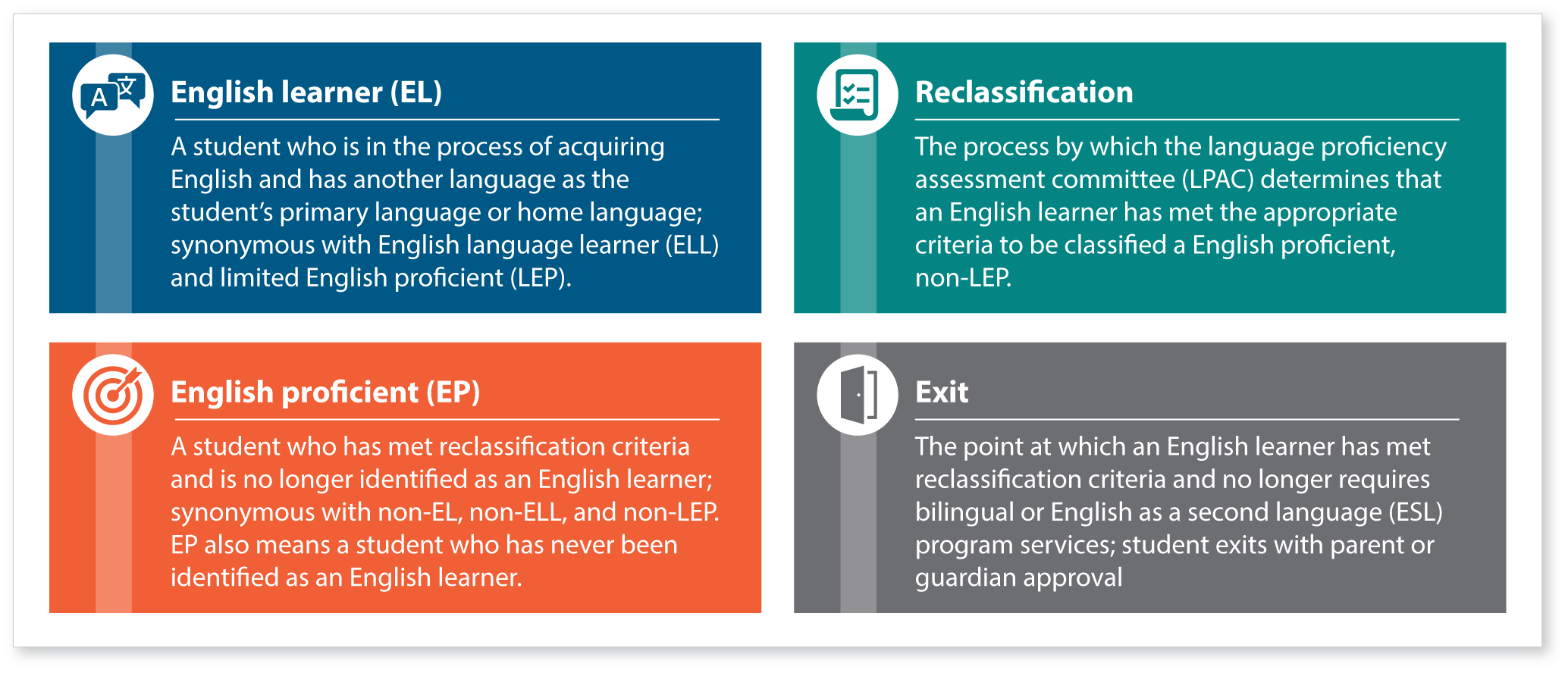- 29.051 - State Policy
- 29.052 - Definitions
- 29.053 - Establishment of Bilingual Education and Special Language Programs
- 29.054 - Exceptions
- 29.055 - Program Content; Method of Instruction
- 29.056 - Enrollment of Students in Program
- 29.0561 - Evaluation of Transferred Students. Reenrollment
- 29.057 - Facilities; Classes
- 29.058 - Enrollment of Students Who Do Not Have Limited English Profociency
- 29.059 - Cooperation Among Districts
- 29.060 - Preschool, Summer School, and Extended Time Programs
- 29.061 - Bilingual Education and Special Language Programs Teachers
- 29.062 - Compliance
- 29.063 - Language Proficiency Assesment Committee
- 29.064 - Appeals
- 29.066 - PEIMS Reporting Requirements

Before starting this web-based training, it is recommended that users review the information in the drop-down boxes below to have a foundational understanding of the law and terms referenced in the modules.
What state and federal requirements are in place to ensure that Texas educators meet the needs of English learners?
Texas Education Code (TEC)
-
For each student in average daily attendance in a bilingual education or special language program under Subchapter B, Chapter 29, a district is entitled to an annual allotment equal to the basic allotment multiplied by:
-
for a student of limited English proficiency, as defined by Section 29.052:
- 0.1; or
- 0.15 if the student is in a bilingual education program using a dual language immersion/one-way or two-way program model; and
- for a student not described by Subdivision (1), 0.05 if the student is in a bilingual education program using a dual language immersion/two-way program model.
-
for a student of limited English proficiency, as defined by Section 29.052:
- At least 55 percent of the funds allocated under this section must be used in providing bilingual education or special language programs under Subchapter B, Chapter 29. A district's bilingual education or special language allocation may be used only for program and student evaluation, instructional materials and equipment, staff development, supplemental staff expenses, salary supplements for teachers, incremental costs associated with providing smaller class sizes, and other supplies required for quality instruction.
- The State Board of Education shall adopt rules requiring a report on the use of funds under Subsection (b) as part of the annual audit under Section 44.008 and shall develop minimum requirements for that report.
-
The commissioner annually shall review each report required under Subsection (c) for the preceding school year and:
- identify each school district that was not in compliance with Subsection (b) during that school year; and
- provide each district identified under Subdivision (1) a reasonable opportunity to comply with Subsection (b).
- The commissioner, in the year following a determination under Subsection (d) that a school district was not in compliance with Subsection (b) for the 2021-2022 school year or a subsequent school year, shall withhold from the district's foundation school fund payment an amount equal to the amount of bilingual education or special language funds the commissioner determines were not used in compliance with Subsection (b). The commissioner shall release to a district funds withheld under this subsection when the district provides to the commissioner a detailed plan to spend those funds in compliance with Subsection (b). In determining whether a school district is subject to the withholding of funding required under this subsection, the commissioner may consider the district's average use of funds for the three preceding school years.
Texas Administrative Code (TAC)
- 89.1201 - State Policy
- 89.1203 - Definitions
- 89.1205 - Required Bilingual Education and English as a Second Language Programs
- 89.1207 - Exceptions and Waivers
- 89.1210 - Program Content and Design
- 89.1215 - Home Language Survey
- 89.1220 - Language Proficiency Assessment Committee
- 89.1226 - Testing and Classification of Students, Beginning with School Year 2019-2020
- 89.1227 - Minimum Requirements for Dual Language Immersion Program Model
- 89.1228 - Dual Language Immersion Program Model Implementation
- 89.1229 - General Standards for Recognition of Dual Language Immersion Program Models
- 89.1230 - Eligible Students with Disabilities
- 89.1233 - Participation of English Proficiency Students
- 89.1235 - Facilities
- 89.1240 - Parental Authority and Responsibility
- 89.1245 - Staffing and Staff Development
- 89.1250 - Required Summer School Programs
- 89.1265 - Evaluation
Commissioner’s Rules (Chapter 89) - SpanishOpens a new window
The Spanish version of Chapter 89 is simply for translation purposes only. The official version of the adopted rules are in English.
Esta versión del Capítulo 89 es solamente para propósitos de traducción. La versión oficial de las reglas adoptadas está en inglés.
Every Student Succeeds Act (ESSA)
Title III, Part A StatuteOpens a new window (pages 153-165)
The following words and terms are used in this subchapter and throughout the training.
Click on the terms below to read the definitions.

These terms are foundational to understanding English learner programming.
Due to the nature of some language program models, a reclassified English proficient student may continue in the program with parent or guardian approval.
The term “English learner” will be used throughout the training to align with the Elementary and Secondary Education Act of 1965 Public Law 115-141, as amended by the Every Student Succeeds Act (ESSA).
The term “English learner” and the introduction of the term “English proficient,” when referring to students who do not need English language support, is intentional. This terminology replaces the use of abbreviations such as EL or EP, to ensure a “people first” approach when referring to the students we serve.
All students who have met the reclassification criteria must have their coding updated in PEIMS.
Think about this analogy:
Identification is to Reclassification as Placement is to Exit.
Identification and reclassification is determined by the LPAC, whereas placement and exit are dependent on parent or guardian approval based on LPAC recommendation.

To ensure equal educational opportunity, as required in the Texas Education Code (TEC), §1.002(a) and TEC 29.051, TAC Chapter 89 Subchapter BB 1201(a), policy states a school district shall:
1. identify English learners based on criteria established by the state;
2. provide bilingual education and ESL programs, as integral parts of the general program
as described in the TEC, §4.002;
3. seek appropriately certied teaching personnel to ensure that English learners are
afforded full opportunity to master the essential knowledge and skills required by the
state; and
4. assess achievement for essential knowledge and skills in accordance with the TEC,
Chapter 29, to ensure accountability for English learners and the schools that serve them.
As stated in Chapter 89.1235
• Bilingual education and ESL programs shall be located in the public schools of the school
district with equitable access to all educational resources rather than in separate facilities.
• In order to provide the required bilingual education or ESL programs, school districts may
concentrate the programs at a limited number of facilities within the school district.
• Recent immigrant English learners shall not remain enrolled in newcomer centers for longer
than two years.
Additional guidance regarding concentrating, or clustering, students at a limited number of
facilities within the district:
• In the context of a bilingual program, a district may cluster bilingual program students at one
or more centrally located campus(es) in order to maximize resources.
Additional guidance regarding concentrating, or clustering, students at a limited number of
facilities within the district:
• In the context of a bilingual program, a district may cluster bilingual program students at one
or more centrally located campus(es) in order to maximize resources.
Additionally, ESL programs may be clustered in a similar fashion. However, when clustering bilingual or ESL programs, districts must not isolate/segregate English learners from English profcient students to the point at which English learners make up the entire school for the duration of their program services.
Notice that an English learner’s participation in a newcomer center, likely composed of all English learners, is limited to two years.
Training Modules


The Purpose of the LPAC Framework
- The Framework for the Language Proficiency Assessment
Committee (LPAC) process includes clarification of the legal requirements for the LPAC and provides documents and forms to facilitate the training of LPAC members. - The forms included in the LPAC Framework are samples for districts to use for the implementation of a bilingual/ESL program.
- Sample forms may be adapted or enhanced to meet each district or charter school’s individual needs for proper documentation.
The LPAC Framework Web-based Training is comprised of six different modules.
- This web-based training is designed to support LEA staff who serve as a designated member of an LPAC.
- Each module will contain information about one section of the LPAC, including an overview video with a check for understanding. After completion of each video, users will be prompted to complete a brief survey and then provided access to a certificate of completion to download and print. Users completing all six videos will have a total of six certificates of completion. It will be a local district decision to determine the requirements around submission of certificates.
- It is recommended that all modules are completed in order, but the course is designed to allow users the flexibility to take the modules in any order.
LPAC Framework Introduction Module
The Introduction Module addresses the purpose, membership, and responsibilities of the language proficiency assessment committee (LPAC) and the organization of the framework and resources that support it.
For detailed information about the Introduction section of the training, please reference the following materials:
Interactive Notes - Optional Tool for your learning
Introduction Training PowerPoint
English Learner FAQ for Introduction
Suggested Forms for this section
Resources
The items listed below will be referenced in the overview video
Financial Accountability System Resource Guide
LPAC Framework Identification Module
The Identification Module addresses timelines, procedures, assessment practices, and decision-making processes for identifying English learners.
For detailed information about the Introduction section of the training, please reference the following materials:
Interactive Notes - Optional Tool for your learning
Identification Training PowerPoint
English Learner FAQ for Identification
Guidance on Identification and Placement of Emergent Bilingual Students/English Learners Prior
to Kindergarten
Suggested Forms for this section
PEIMS Codes Prerequisites Page
Resources
The items listed below will be referenced in the overview video
Home Language Survey (HLS)
Identification / Reclassification Flowchart
Guidance on Identification/Reclassification: LPAC and ARD Committee Collaboration
LPAC Framework Placement Module
The Placement Module addresses the rights of parents regarding the process of identification and placement, benefits of program services, and approval for program participation.
For detailed information about the Introduction section of the training, please reference the following materials:
Interactive Notes - Optional Tool for your learning
Placement Training PowerPoint
English Learner FAQ for Placement
Program Brochures - Bilingual / ESL
Suggested Forms for this section
PEIMS Codes Prerequisites Page
Resources
The items listed below will be referenced in the overview video
Identification / Reclassification Flowchart
LPAC Framework English Language Services Module
The English Learner Services Module addresses the four state-approved bilingual program models and the two state-approved ESL program models, staffing requirements, and procedures for filing a bilingual exception or an ESL waiver.
For detailed information about the Introduction section of the training, please reference the following materials:
Interactive Notes - Optional Tool for your learning
English Language Services Training PowerPoint
English Learner FAQ for English Language Services
Suggested Forms for this section
PEIMS Codes Prerequisites Page
Resources
The items listed below will be referenced in the overview video
English Learner Program Implementation
Guidance on Identification/Reclassification: LPAC and ARD Committee Collaboration
LPAC Framework Review and Reclassification Module
The Review and Reclassification Module addresses the requirements for conducting ongoing and annual review of English learner progress and the criteria for reclassification of students as English proficient.
For detailed information about the Introduction section of the training, please reference the following materials:
Interactive Notes - Optional Tool for your learning
Review and Reclassification Training PowerPoint
English Learner FAQ for Review and Reclassification
Suggested Forms for this section
PEIMS Codes Prerequisites Page
TEA Accommodation Resources Page
Resources
The items listed below will be referenced in the overview video
LPAC Decision-Making Guide *Please contact the TEA Student Assessment Division with any questions regarding testing for English learners.
Guidance on Identification/Reclassification: LPAC and ARD Committee Collaboration
Reclassification Criteria Chart - 2020-2021
TELPAS Alternate
LPAC Framework Monitoring and Evaluation Module
The Monitoring and Evaluation Module addresses the differences between state and federal monitoring requirements for reclassified students and outlines key elements of the annual program evaluation.
For detailed information about the Introduction section of the training, please reference the following materials:
Interactive Notes - Optional Tool for your learning
Monitoring and Evaluation Training PowerPoint
English Learner FAQ for Monitoring and Evaluation
Suggested Forms for this section
PEIMS Codes Prerequisites Page
Resources
The items listed below will be referenced in the overview video
Bilingual Exception and ESL Waivers
LPAC Parent Training-Spanish - Slides(PDF)
LPAC Parent Training-Spanish - Trainer Notes(PDF)
LPAC Parent Training-Spanish - Participant Packet(PDF)

